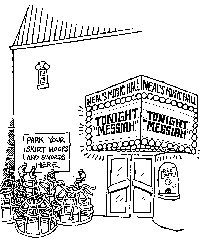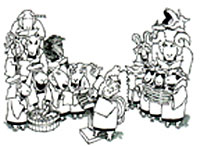Joy to the World! by Lucie Renaud
/ December 1, 2000
Version française...
 It’s that time again: Christmas lists,
carols, fat men in red suits, and Messiah.
Don’t get excited—it’s Händel’s oratorio
we’re talking about, not the Second Coming! The most famous part
of this work is certainly the “Hallelujah Chorus.”
Tradition has it that King George II of England was so overwhelmed
when he first heard this chorus at its London premiere in 1743 that
he immediately rose to his feet. Audiences the world over still
follow this tradition. But who is Händel, anyway? It’s that time again: Christmas lists,
carols, fat men in red suits, and Messiah.
Don’t get excited—it’s Händel’s oratorio
we’re talking about, not the Second Coming! The most famous part
of this work is certainly the “Hallelujah Chorus.”
Tradition has it that King George II of England was so overwhelmed
when he first heard this chorus at its London premiere in 1743 that
he immediately rose to his feet. Audiences the world over still
follow this tradition. But who is Händel, anyway?
Young Händel
George Frederick Händel was born in Halle, Germany, on
February 23, 1685, a few weeks before Bach. (The two musicians never
met, although Bach lived in this region all his life.)
Händel’s father was a surgeon-barber, a common combination
of professions in those days, although it seems rather funny to us
today. (But after all, both jobs require the skilful use of the
blade!) George showed surprising musical gifts from a very young age.
His father, who was 63 when George was born and had very
old-fashioned ideas, didn’t give his son much encouragement.
Never-theless the boy managed to hide a clavichord in the attic,
probably with his mother’s help. The clavichord was a forerunner
of the piano. It looked something like a small synthesizer, but made
very soft sounds, which was probably why Händel’s father
never found out about his son’s instrument. The boy had no
teacher to help him and practised by himself. One day fortune smiled
on the young musician. The Duke of Saxe Weissenfels heard him and
ordered the boy’s father to give him proper music lessons. The
local organist became his teacher and taught him the basics of organ
playing as well as composition.
 After his father’s death in 1697, Handel made
up his mind to study law. Perhaps he felt morally obliged to do as
his father wished, despite the fact that he had already shown
exceptional virtuosity as an organist and harpsichordist, was an
excellent violinist, and already had two trunks filled with
composition! When he began studying at Halle University, he accepted
a job as organist to help pay his expenses and to be able to keep up
his music. After his father’s death in 1697, Handel made
up his mind to study law. Perhaps he felt morally obliged to do as
his father wished, despite the fact that he had already shown
exceptional virtuosity as an organist and harpsichordist, was an
excellent violinist, and already had two trunks filled with
composition! When he began studying at Halle University, he accepted
a job as organist to help pay his expenses and to be able to keep up
his music.
Discovering opera
In 1703, after a year of legal studies,
Händel decided that his future lay with music. He moved to
Hamburg, a more cosmopolitan city. There he taught music and played
violin and harpsichord in the opera orchestra. By the time he was 20,
he composed his first opera, Almira, which was
warmly received by the public. Händel adored opera. In 1706, he
travelled to Italy, the place all composers of the time dreamed of
visiting, a bit like Hollywood is for actors today.
At the age of 25, Händel decided to accept a
permanent position with a German prince. (In those days Germany
wasn’t one big country. It was made up of many principalities,
each with a ruler such as a duke or prince.) Händel soon became
bored and asked for a year off to visit London. Londoners had just
discovered Italian opera, and it was all the rage. (Travel was very
slow and letters were the only means of communication. It could take
several years for a composer’s work to be heard in another
country).
Händel reworked some “old” material
and came up with the opera Rinaldo, which took
English audiences by storm. Although he never lost his great passion
for travel, he finally settled in London in 1714, and it remained his
home until his death in 1759.
Messiah
In July 1741, Händel became discouraged by
the lack of interest in his two most recent operas and decided to
give up writing them (he had already composed 40 operas). Instead, he
focussed on oratorios. An oratorio is a large-scale composition for
soloists, choir, and orchestra. It could be compared to an opera
without stage sets or costumes. The subject is always religious.
Händel’s friend Charles Jennens had
already written the librettos (the story and words) for two of his
oratorios. Now Jennens suggested a new libretto, based on the King
James Version of the Bible. Jennens chose several events from the
life of Jesus, using well-known passages from the New Testament. The
rest was based on less familiar books of the Old Testament.
Händel was enthusiastic about the
project—so inspired, in fact, that he finished the work in three
weeks. Messiah has three parts, covering the birth,
death, and resurrection of Jesus. Händel’s talent as a
composer of opera enabled him to capture the dramatic quality of each
text in his music. As he composed the “Hallelujah Chorus”,
he is reported to have said: “I did think I did see all Heaven
before me and the great God Himself.” A magnificent vision,
judging by the splendour of this music!
Händel gave the work its first public
performance in Dublin, Ireland, on April 12, 1742. The concert was
held to raise money for the city’s prison and two of its
hospitals. The event was highly publicized by the newspapers of the
time, and 700 people crammed the hall on the night of the concert.
The announcement asked ladies to come without their hooped petticoats
and the gentlemen without their swords, so that more people could
squeeze into the hall. The evening was a brilliant success.
When Händel decided to present
Messiah in London in 1743, the audience was not
impressed, despite the king’s enthusiasm. People disapproved of
a religious text being sung in a theatre, and even more shocking, by
an actress!
Seven years later, Händel decided to present
the oratorio again. The concert took place during Lent (it
wasn’t performed at Christmas in those days). As with the
earlier performance, it was held to raise money for the Foundling
Hospital. The Covent Garden opera house was packed. Success at last!
After that Händel presented the work every year until his death,
always to help out some charity. Since that time,
Messiah has never lost its popularity, and it has become
one of the most famous choral works in the world.
Yesterday and today
Today’s way of presenting
Messiah is a little different from what Händel
had in mind.
• Händel used an all-male choir, with
the soprano and alto parts sung by boys or countertenors. Solos could
be sung by women.
• The choir stood for the whole performance
(three hours), so there were no pauses and no noises from chairs
scraping the floor.
• The five soloists sang with the choir
between solos, keeping the
balance of sound between the orchestra and
choir more natural.
• Händel “adapted” the various
pieces from one performance to another, even changing the type of
soloist. A man might replace a woman for a particular concert, for
example, or Händel might transpose a piece to fit the voice of
the soloist of the evening.
• There was no orchestra conductor as we know
it. Händel conducted from his position at the harpsichord and
hired only musicians in whom he had total confidence. There were 35
musicians in his orchestra and 19 singers in his choir. This was very
different from nineteenth-century concerts+ which sometimes had up to
3,000 performers!
[Translated by Jane Brierley]
Version française... | 

